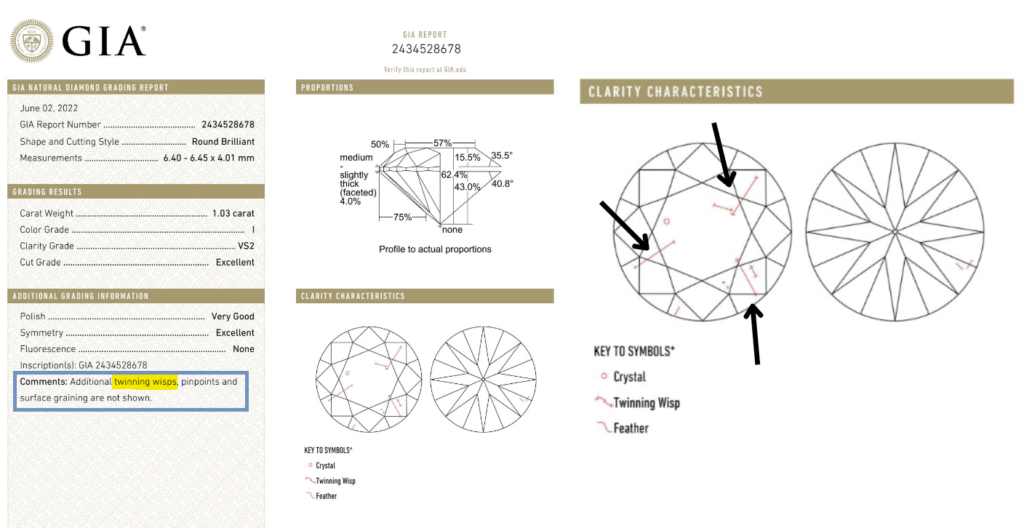We are reader-supported. Buying through any red colored link on our site may earn us commissions. Learn More.
Up to 30% off engagement rings and select jewelry at James Allen!
What is a Twinning Wisp?
Every diamond has its imperfections. Some are noticeable, while others are so tiny and faint that no one ever sees them. One type of diamond inclusion is twinning wisps.
Twinning wisps are a type of inclusion or imperfection in a diamond that occur when there are areas of irregular crystal growth. These inclusions can look like a series of pinpoints, clouds, or feathers, and they often appear in twinned diamonds—diamonds that began as separate crystals but fused together during their formation. Whether twinning wisps are “good” or “bad” is subjective and depends on the visual impact they have on the diamond. In some cases, they can be almost imperceptible to the naked eye, having minimal impact on the diamond’s overall appearance. In other instances, they can cause the diamond to look cloudy or hazy, affecting its brilliance and thus its value.
Why you should trust us
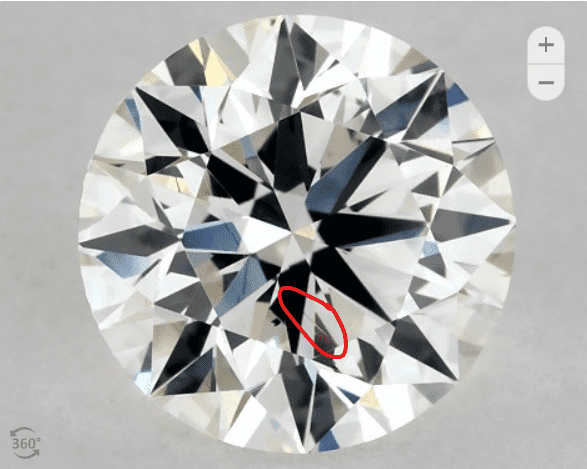
Twinning wisps are different from other types of inclusions such as stand-alone feathers and single pinpoint inclusions. They are the result of the diamond’s natural growth and irregularity in the crystal structure. Fancy shape diamonds such as baguettes and emerald cuts are more likely to have twinning wisps.
A clarity plot on a diamond’s certificate marks the location and size of twinning wisps (often denoted as a red curvy line with slash marks in it).
Do Twinning Wisps Affect a Diamond’s Brilliance?
Twinning wisps can impact a diamond’s brilliance if they are dark or concentrated. If the inclusions are dense or there are large clusters of twinning wisps, these imperfections can scatter light and cause the diamond to look cloudy.
In most cases, twinning wisps are only visible at 10x or 35x magnification, meaning you — and everyone else — won’t be able to see them with the naked eye. And they won’t affect a diamond’s brilliance. But it all depends on the specific diamond and twinning wisp inclusion.
It’s unlikely that a twinning wisp affects the diamond’s brilliance if:
- It’s not visible to the naked eye
- It’s faint or light in color
- The inclusions aren’t densely concentrated
- The diamond is VS2 clarity or better
- Example: 1.00ct I VS2 round cut diamond from James Allen
It’s likely that a twinning wisp affects a diamond’s brilliance if:
- The diamond appears cloudy or hazy
- The twinning wisp is visible to the naked eye
- The twinning wisp is brown, yellow, or black in color
- There are many twinning wisps near each other or the twinning wisp is large
- The diamond is SI1 clarity or lower
- Example: 1.00ct G SI2 round cut diamond from James Allen
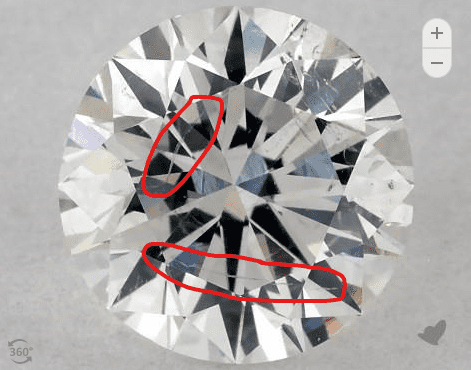
The most important factor when assessing twinning wisps — and diamond clarity in general — is determining if it’s eye clean. Eye-clean diamonds mean you can’t see any imperfections with your bare eye. By looking at high-res photos and videos (quality online vendors offer these), you can review a diamond up close. If the twinning wisp is noticeable or there’s a cloudy haze to the diamond, it’s best to look for a different stone.
If you’re unsure how to assess a diamond for clarity or twinning wisps, reach out to our experts.
How Do Twinning Wisps Look?
Twinning wisps look like thin, wispy streaks that can be light or dark. They can be dense with many imperfections close together, or more spread out. Twinning wisps are usually not visible to the naked eye but can be seen under 10x or 35x magnification. They’re most noticeable in diamonds weighing 2 carats or more and in fancy shape diamonds such as emerald cuts and asscher cuts.
Are Twinning Wisps Light or Dark?
Twinning wisps can be light or dark, depending on if the inclusion is colorless or has yellow, brown, or black tinting. You can look closely at a diamond with a high-res photo or video with vendors like James Allen to determine the coloring.
Lighting can impact how the twinning wisp appears, so be sure you look at the diamond under natural light if you’re shopping in a store. If you shine a light behind the diamond instead of on top of it, twinning wisps can appear darker than they actually are.
The Difference Between Cloud and Twinning Wisp Diamond Inclusions
A cloud inclusion is a group of small pinpoint imperfections (usually three or more) clustered together. They can make a diamond look hazy and dull. A twinning wisp inclusion is a thin line of imperfections made up of pinpoints, tiny needles, or clouds. In most cases, a twinning wisp doesn’t impact the diamond’s beauty or dullness, but can in certain situations.
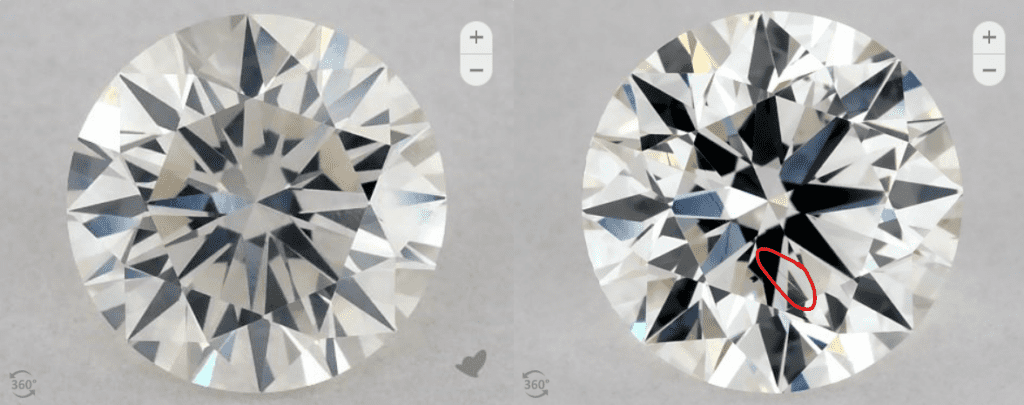
Cloud inclusions are caused by debris and other diamonds that enter the crystal lattice structure. They can also form during the cutting process if small fragments enter the diamond. Twinning wisps occur when the diamond is forming, often due to a nearby diamond impacting the crystal structure.
Twinning Wisps in Diamond Grading Reports
Diamond grading entities like the GIA and AGS denote twinning wisps on their certificates. There’s a clarity plot on the certificate that shows the location, size, and quantity of twinning wisps. The symbol for twinning wisps is usually a red curvy line with slashes in it.
The certificate and clarity plot can help you decide if the diamond’s twinning wisps are detrimental to its beauty or brilliance. But in the end, reviewing the diamond up close is the best way to determine if it’s eye-clean or has noticeable imperfections.
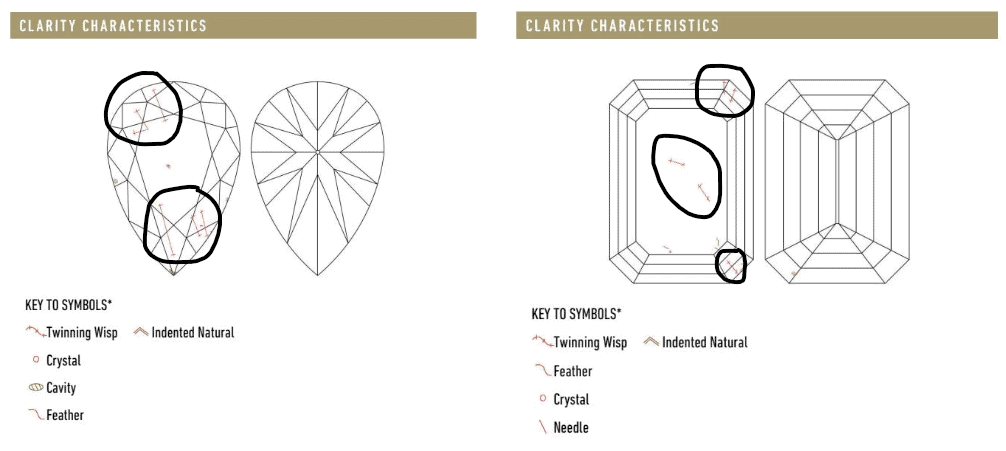
Twinning Wisps: Are they Good or Bad?
Twinning wisps aren’t inherently bad or good, as they are part of a diamond’s natural growth and development. If a twinning wisp is dark, noticeable to the naked eye, or causes a cloudy appearance, it can deter from the diamond’s beauty.
But it’s important to remember that no diamond is perfect. If a twinning wisp isn’t visible to the naked eye, then it does no harm to the diamond’s beauty and value.
Should You Buy a Diamond with Twinning Wisp?
A twinning wisp alone shouldn’t discourage you from buying a diamond. Twinning wisps are just one type of inclusion and often don’t impact a diamond’s beauty. If the twinning wisp isn’t visible to the naked eye and doesn’t make the diamond cloudy, it can be an excellent diamond. In fact, a diamond with a lower clarity grade that’s still eye-clean can save on cost without sacrificing quality.
We suggest you look at each diamond closely, but follow these general guidelines for twinning wisps:
Round cut diamonds: A VS2 or SI1 typically offers the best value for clarity, because they’re usually eye-clean even if they have a twinning wisp.
Princess, cushion, pear, oval, radiant, marquise, heart, and trillion shapes: An SI1 or SI2 clarity grade is usually eye-clean and offers the best value
Asscher, baguette, emerald cuts: VS2 or better is best for these diamond shapes, because they tend to show twinning wisps the easiest.
FAQs: Twinning Wisps
What are the worst inclusions in a diamond?
The worst inclusions in a diamond are dark, large, concentrated together, or in a prominent location. There isn’t a single type of inclusion, such as feather or pinpoint, that is the worst. It’s more important to look at the number, size, location, and color of inclusions. Too many inclusions can make a diamond look cloudy and a dark blemish can be a glaring eyesore.
What is a crystal inclusion in a diamond?
A crystal inclusion in a diamond is an imperfection caused by a mineral crystal within the diamond. It can be colorless or have a tint such as black, red, or green. Crystal inclusions are usually a collection of small diamonds or minerals that enter a diamond during its formation.
What is a diamond feather?
A diamond feather is a small crack in the diamond’s internal structure that looks feathery and is either colorless or dark in appearance. Some feather inclusions are obvious while others are invisible to the naked eye. They can be large or small.
Are inclusions good in a diamond?
Inclusions are present in all diamonds, and they’re not inherently good or bad. Most inclusions can’t be seen with the naked eye and thus have no impact on the diamond’s beauty or value. You should avoid inclusions that are dark, noticeable, or cause the diamond to look dull as they can diminish the stone’s brilliance and worth.
Final Thoughts on Twinning Wisps
Diamonds with twinning wisps can still be stunning, high-quality stones. By looking at the diamond up close, you can determine if the inclusion impacts the diamond’s appearance. Or you can ask one of our experts for help.
When evaluating a diamond’s clarity, the main goal is to find an eye-clean diamond. If you can find one in a lower clarity grade, you can save on price, allowing you to spend more on the most critical component: the diamond cut.

- No questions asked returns within 30 days of shipment. James Allen will send you a paid shipping label to return the ring.
- Lifetime Warranty
- Free International Shipping
- Free prong tightening, repolishing, rhodium plating and cleaning every 6 months
- Provide insurance appraisals
- One free resizing within 60 days of purchase
- Free ring inscriptions
- Best-in-class high quality imagery of all diamonds in stock
- 24/7 Customer Service
- Best-in-class packaging


- No questions asked returns within 30 days of shipment. Blue Nile will send you a paid shipping label to return the ring.
- Lifetime Warranty
- Free Shipping
- Free prong tightening, repolishing, rhodium plating and cleaning every 6 months
- Provide insurance appraisal
- One free resizing within the first year of purchase
- High quality images of about half of their diamonds
- 24/7 Customer Service
- 100% credit towards future upgrades (must be at least double in value)
- Best in class fulfillment

Still afraid of getting ripped off?
Before you buy a diamond, get personal buying advice from industry veterans. We'll help you get the best diamond for the money.
Ask your diamond purchase question here
DISCLAIMER: We don't use your email for marketing. Period.
You Might Like
Diamond Prices: A Complete Guide
A diamonds’ price is determined primarily by the 4 Cs of the diamond. On the wholesale level, diamond prices are first based on a diamond shape and
The Best Places to Buy Engagement Rings
Buying an engagement ring is often one of the first major purchases in a person's life. The process can be fraught with tension as there are so m
1 Carat Diamond Price & Buying Guide
A wide range of 1 carat diamonds exist both in online markets and local diamond jewelry stores. Not only are there significant differences in beauty

